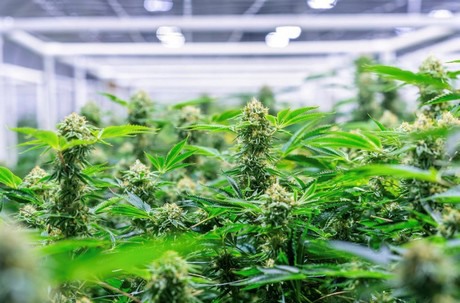In this second part of this series on cannabis greenhouses by Fullbloom, we are going to explore the world of light deprivation greenhouses, and the different types of structures that are available to cannabis growers. After a brief digression on fertigation and watering, we are going to discuss the challenges of design and structure strength, both from a cultivation and a regulatory standpoint. Finally, we are going to conclude with a discussion on two of growers’ enemies: pollen and pests. If you missed the first part, click here to catch up!
Controlling the photoperiod is something nearly every cannabis grower does. In a fast-growing industry, it’s important to harvest multiple times a year to stay competitive. To do this, growers can use light deprivation greenhouses. Roll-to-peak (external) light dep systems are a budget friendly way to control the photoperiod on small cannabis greenhouses that are in moderate climates with low wind exposure. At Fullbloom, we have spent years of R&D developing a unique roll-to-peak system customizable to almost any structure. Used in conjunction with our light diffusing poly, allows any grower to use an affordable system without sacrificing light exposure to their canopy.

Internal Light Dep is intended for use on large scale, heavy-duty greenhouses. Using an internal light dep curtain system is essential in high wind and snow areas as the curtains are protected by the structure. The internal curtain can act as a thermal barrier when temperatures drop at night, maintaining that ideal climate.
Fertigation and watering
Here is the only often debatable subject for automation controls. Many cannabis greenhouse growers prefer to hand water their plants so they can get hands on with each plant and check it for bugs or disease before those things have time to spread. With that in mind, you can still have automated irrigation systems in place or some growers choose to use full fertigation systems that literally mix and deliver the nutrients right to your plants based on your plants current needs.
Design & Structure Strength
While the majority of US greenhouse Cannabis cultivation practices began in California, it does not mean those same principles and greenhouse designs will work in other states like Oklahoma or the northern states. In fact, we often hear of the California style hoop houses caving in and or otherwise flying away in storms. Choosing a cannabis greenhouse that is engineered for your property and specific climate conditions should be the first thing you do.
Do you need an engineered structure? All states differ in building code regulations and permitting requirements. Some states will have a number of counties that will allow farmers to build greenhouses without additional permitting if their property falls within an agricultural exemption, while many other states will have strict requirements for permitting your greenhouse. Understanding this is critical for Cannabis growers in order to avoid fines and wasted time for putting up a non-permissible structure. At Fullbloom, we have AG exempt greenhouse options, and structures that can handle extreme wind and snow loads with engineer-stamped plans available.
Does it have enough room for your plants? Cannabis needs room to grow vertically, and sometimes horizontally depending on the strain and your growing preference. Many successful greenhouse cannabis growers want to use grow lights or elevate their plants onto benches and raised beds. If the greenhouse you buy has an interior curtain or peak height that is 9’-10’ft off the ground, you will not be able to use high strength grow lights during the winter or veg periods without burning your plants. Unfortunately, many of the greenhouses on the market right now are designed for small fruiting plants and the sidewalls, curtain height, and engineering are not intended for Cannabis.
Pest, Pollen, & Pesticide Mitigation
As both commercial and personal Cannabis and Hemp grows are spreading throughout the US, so comes the added risk of your plants receiving some of these undesirable problems. As they say, an ounce of prevention and prevent a pound of pain (or something like that).
Pollen
Male hemp and cannabis pollen is not something you want ruining your hard earned work. Having a greenhouse in general gives you leaps and bounds more protection then outdoor growers. However, since pollen can travel for many many miles, extra precaution should be taken if you’re at all concerned about your neighbors. During the risky times of year (when male pollen would normally spread) it is essential to run the cannabis greenhouse as a sealed environment (doing so while keeping temperature and humidity under control is the hard part). Using an evaporative cooling wall and/or fogging system will actually trap and make pollen inert before it has time to get to your plants and has thus far been the best method we’ve seen available for the industry. Specialized pollen intake filters can also help in areas that need extra protection. As long as your intake air comes in clean, and there is no other source of air coming into the greenhouse - you will be safe from pollen.
Pests
Pests and insects will often come in through your intakes, fans, and open sidewalls. Unlike pollen, you will need to protect your plants from pests year round. Using an anti-insect netting on your intakes and sidewalls will give you a big boost in keeping your cannabis greenhouse bug free, especially from larger pests, but even leaf miners and aphids can be blocked with a tight mesh. However, spider mites and other bugs can still be tracked into your greenhouse, sot is essential to have regular preventative pest spraying routines in place. This can be done with OMRI/Organic options via an automated overhead fogging system.
Pesticides
Any cannabis greenhouse grower that cares about their buyers, and/or wants to sell their product to a licensed dispensary, will need to protect their plants from pesticides. Outdoor growers are in the worst position of any growing method as pesticides from neighboring farms can easily cross contaminate yours. Ensure you get to know your neighbors and when they spray, and ensure your greenhouse is prepared to run as a sealed environment during those times.
For more information:
Fullbloom Greenhouse
500 Rossanley Dr. Medford, OR 97501
1-866-252-9641
contact@fullbloomlightdep.com
fullbloomlightdep.com
